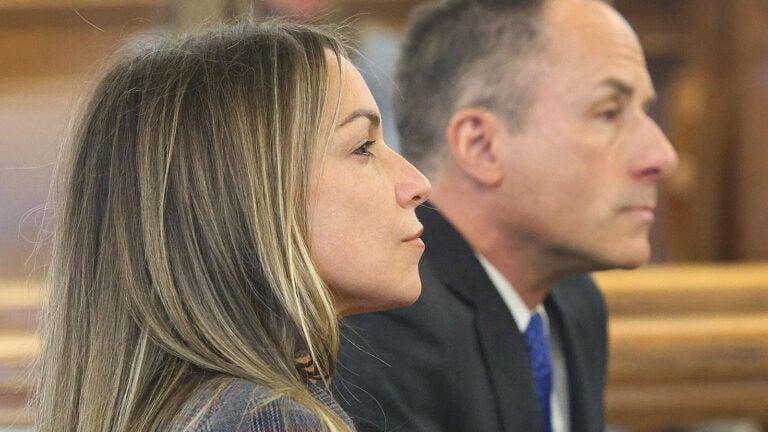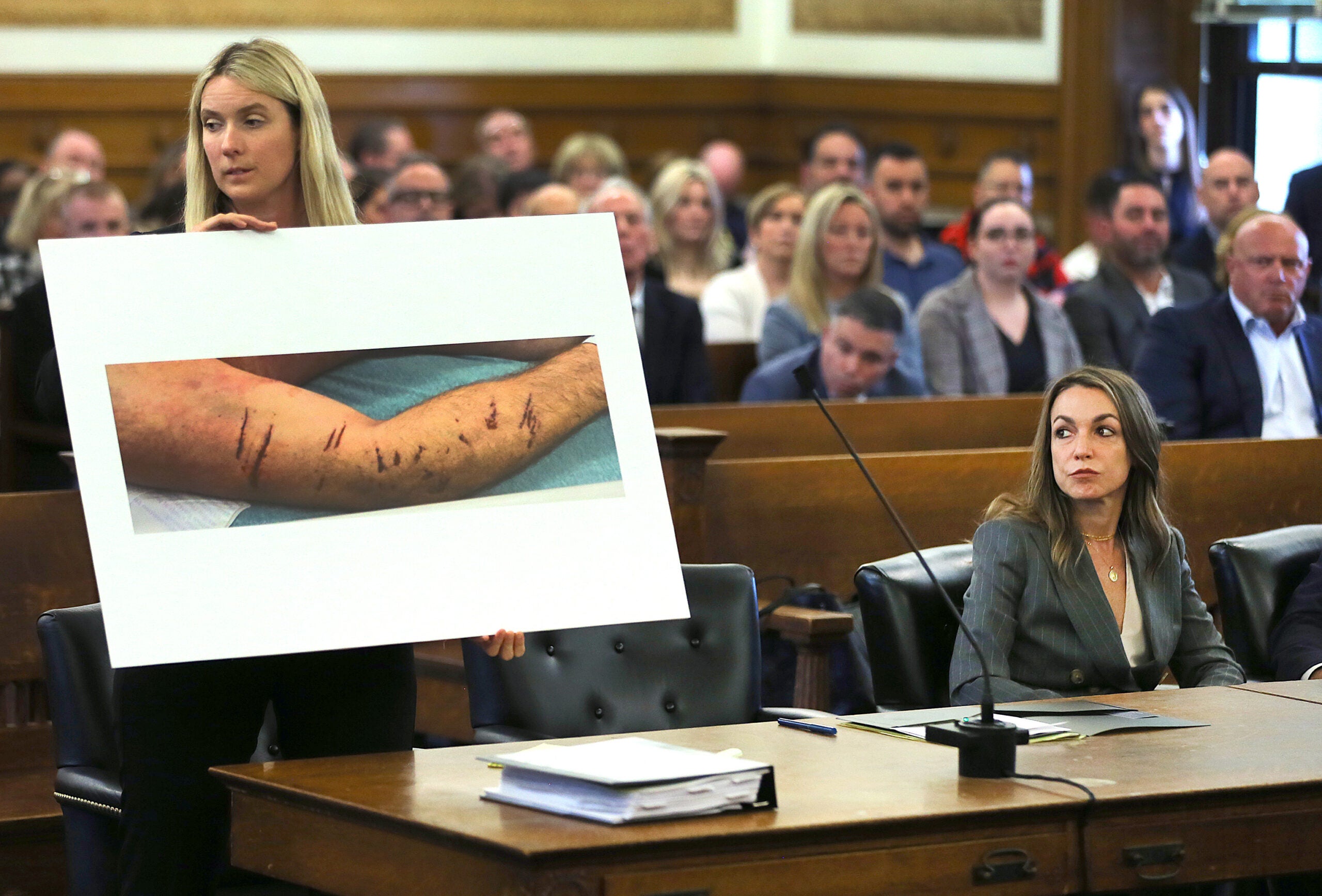Newsletter Signup
Stay up to date on all the latest news from Boston.com

Lawyers for murder defendant Karen Read ignited a firestorm last spring with allegations concerning a witness’s questionable Google search — an apparent bombshell in the investigation into the death of Read’s boyfriend, Boston Police Officer John O’Keefe.
Since then, the debate surrounding O’Keefe’s death has only intensified as lawyers, online sleuths, and legal pundits alike pored over the evidence and presented their own theories in the high-profile case.
To hear prosecutors tell it, Read, 44, backed her SUV into O’Keefe while dropping him off at another Boston officer’s home in Canton following a night of drinking. While authorities allege the Mansfield woman left O’Keefe to die in the snow after midnight on Jan. 29, 2022, Read’s attorneys say she is being framed in a widespread cover-up among law enforcement and witnesses.
Read has pleaded not guilty to charges of second-degree murder, motor vehicle manslaughter while driving under the influence, and leaving the scene of a collision causing injury and death.
With her trial slated to begin Tuesday, here’s a brief guide to some of the most contentious pieces of evidence in the case.

According to prosecutors, a doctor with the Office of the Chief Medical Examiner documented wounds on O’Keefe’s right forearm, two swollen black eyes, cuts on his face and the back of his head, and multiple skull fractures that led to bleeding in his brain.
“The doctor opined that the extensive injuries to his head likely rendered Mr. O’Keefe incapacitated,” prosecutors said in a February court filing. “The doctor further opined that upon viewing Mr. O’Keefe’s injuries and her examination of the body, she observed no signs of Mr. O’Keefe being involved in any type of physical altercation or fight.”
Read’s lawyers have pushed back on the medical examiner’s findings.
“Of course there’s evidence that he was in a fight,” defense attorney Alan Jackson said during a May hearing. “The back of his hands, deeply bruised. Those are called defensive wounds; I don’t care what their medical examiner called it.”
He also characterized the wounds on O’Keefe’s arm as animal claw and bite marks, noting homeowner Brian Albert previously owned a pet German shepherd. In a February court filing, however, prosecutors said there was no canine DNA found on swabs taken from O’Keefe’s clothing in areas near his injuries.
Several witnesses who were at Albert’s house on Jan. 29, 2022, told investigators O’Keefe never made it inside the home.
However, Read’s lawyers say O’Keefe’s phone data suggests otherwise. In an April 2023 court filing, the defense asserted that O’Keefe’s Apple Health data indicated he took 80 steps and climbed the equivalent of three flights of stairs at the Fairview Road property.
“To call this data unreliable is an understatement,” prosecutors responded in a subsequent memo, asserting that those steps were recorded before O’Keefe’s cellphone location data showed him arriving at the home.
Prosecutors further noted that the same Apple Health data indicated O’Keefe took several steps hours after he’d been pronounced dead. Jackson, however, chalked that discrepancy up to “sloppy policing” and suggested the posthumous steps reflected a police officer walking around with O’Keefe’s phone in evidence.
As further proof of the alleged cover-up, defense attorneys have pointed to a Jan. 29, 2022, Google search witness Jennifer McCabe — Brian Albert’s sister-in-law — made for “ho[w] long to die in cold.” Read’s lawyers say McCabe made the search at 2:27 a.m., hours before she, Read, and another woman found O’Keefe’s body on Albert’s lawn.
Last month, Jackson further alleged that a special agent with the FBI confirmed the accuracy of the 2:27 a.m. timestamp.
Yet prosecutors say the timestamp is based on a Write Ahead Log (WAL) file, which temporarily stores data before it is written into the database. They posit McCabe made the Google search after finding O’Keefe’s body, using the same Safari tab she’d opened earlier that morning to pull up a youth basketball website.
As they searched for O’Keefe on Jan. 29, 2022, Read allegedly asked McCabe, “Could I have hit him?” and “Did I hit him?”
A Canton firefighter who responded to Fairview Road that morning told investigators Read repeatedly said “I hit him, I hit him, I hit him” when asked how O’Keefe had been injured. According to prosecutors, several other witnesses and first responders testified they heard Read say the same thing.
In an interview with ABC’s “Nightline” that aired last August, Read claimed the statement was phrased as a question.
“I said ‘I hit him.’ It was preceded by a ‘did’ and proceeded by a question mark,” she said in the interview. “What I thought could have happened was that, ‘Did I incapacitate him unwittingly, somehow, and then in his drunkenness, [he] passed out?’”
However, she said it was “not possible” she might have hit O’Keefe unintentionally.
Investigators who examined the back of Read’s SUV reportedly found scratches, chipped paint, a dent, and a shattered tail light missing red and clear plastic. In the area where O’Keefe’s body was found outside Albert’s home, authorities allegedly discovered pieces of plastic consistent with Read’s broken tail light.
According to prosecutors, trace analysis and forensic testing also identified O’Keefe’s DNA on the broken tail light and microscopic pieces of red and clear plastic on his clothing.
“Comparison testing was conducted, and the results demonstrate that the microscopic pieces of red and clear plastic are consistent with the broken pieces of plastic from [Read’s] right rear taillight,” a February court filing stated.
Read’s lawyers have raised questions about the pieces of tail light allegedly recovered from the scene; speaking to ABC News last summer, Jackson asserted that the tail light shards “were planted after the fact.”
The defense has also expressed concerns about documentation and chain-of-custody issues, given investigators allegedly found additional pieces of tail light outside Albert’s home once some of the snow had melted.

As for how the tail light was damaged in the first place, the defense has offered two possible explanations: “One theory is that the defendant broke the tail light of her vehicle by striking the victim’s parked vehicle. The second theory is that the Commonwealth broke the tail light after it seized the vehicle and planted evidence at the crime scene,” prosecutors summarized in a September motion.
Prosecutors acknowledged in February that home surveillance video shows Read’s SUV coming close to O’Keefe’s parked car later that morning, though they said investigators didn’t find any pieces of Read’s tail light in the driveway.
Complicating matters further, Jackson alleged in court last month that a crash reconstruction expert hired by federal officials probing the investigation into O’Keefe’s death concluded O’Keefe’s injuries “were inconsistent with the damage on the car. That the damage on the car was inconsistent with having made contact with John O’Keefe’s body.”
The defense has also pointed to information from a snowplow driver who cleared Fairview Road the day O’Keefe died and allegedly told police he didn’t see a body outside Albert’s home when he passed by that morning. He did, however, tell investigators he saw a small SUV parked in front of the house.
“The plow driver’s testimony should end this case. To put it simply, no body at 2:30 a.m. means Karen Read is innocent,” defense attorney David Yannetti said during a September hearing. “Forget about all the other evidence that points to her innocence; this one fact alone prevents the commonwealth from ever convicting her.”
Stay up to date on all the latest news from Boston.com
Stay up to date with everything Boston. Receive the latest news and breaking updates, straight from our newsroom to your inbox.
Conversation
This discussion has ended. Please join elsewhere on Boston.com